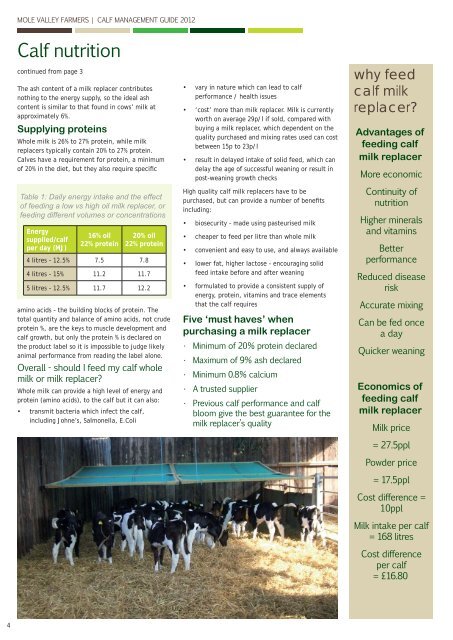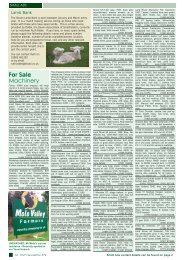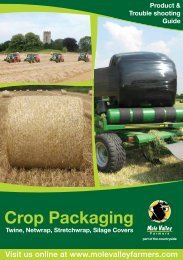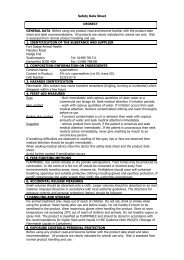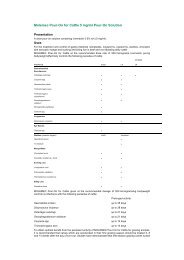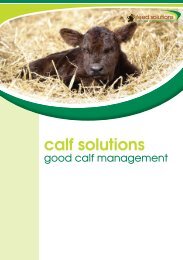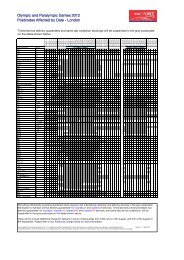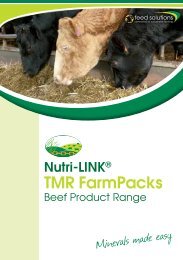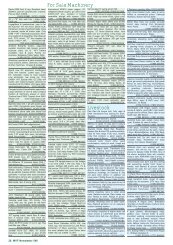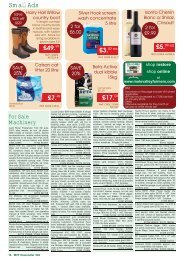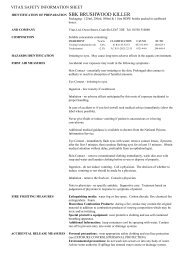MoleValley Calf - Mole Valley Farmers
MoleValley Calf - Mole Valley Farmers
MoleValley Calf - Mole Valley Farmers
Create successful ePaper yourself
Turn your PDF publications into a flip-book with our unique Google optimized e-Paper software.
4<br />
MOLE VALLEY FARMERS | CALF MANAGEMENT GUIDE 2012<br />
<strong>Calf</strong> nutrition<br />
continued from page 3<br />
The ash content of a milk replacer contributes<br />
nothing to the energy supply, so the ideal ash<br />
content is similar to that found in cows’ milk at<br />
approximately 6%.<br />
Supplying proteins<br />
Whole milk is 26% to 27% protein, while milk<br />
replacers typically contain 20% to 27% protein.<br />
Calves have a requirement for protein, a minimum<br />
of 20% in the diet, but they also require specifi c<br />
Table 1: Daily energy intake and the effect<br />
of feeding a low vs high oil milk replacer, or<br />
feeding different volumes or concentrations<br />
Energy<br />
supplied/calf<br />
per day (MJ)<br />
16% oil<br />
22% protein<br />
20% oil<br />
22% protein<br />
4 litres - 12.5% 7.5 7.8<br />
4 litres - 15% 11.2 11.7<br />
5 litres - 12.5% 11.7 12.2<br />
amino acids - the building blocks of protein. The<br />
total quantity and balance of amino acids, not crude<br />
protein %, are the keys to muscle development and<br />
calf growth, but only the protein % is declared on<br />
the product label so it is impossible to judge likely<br />
animal performance from reading the label alone.<br />
Overall - should I feed my calf whole<br />
milk or milk replacer?<br />
Whole milk can provide a high level of energy and<br />
protein (amino acids), to the calf but it can also:<br />
• transmit bacteria which infect the calf,<br />
including Johne’s, Salmonella, E.Coli<br />
• vary in nature which can lead to calf<br />
performance / health issues<br />
• ‘cost’ more than milk replacer. Milk is currently<br />
worth on average 29p/l if sold, compared with<br />
buying a milk replacer, which dependent on the<br />
quality purchased and mixing rates used can cost<br />
between 15p to 23p/l<br />
• result in delayed intake of solid feed, which can<br />
delay the age of successful weaning or result in<br />
post-weaning growth checks<br />
High quality calf milk replacers have to be<br />
purchased, but can provide a number of benefi ts<br />
including:<br />
• biosecurity – made using pasteurised milk<br />
• cheaper to feed per litre than whole milk<br />
• convenient and easy to use, and always available<br />
• lower fat, higher lactose – encouraging solid<br />
feed intake before and after weaning<br />
• formulated to provide a consistent supply of<br />
energy, protein, vitamins and trace elements<br />
that the calf requires<br />
Five ‘must haves’ when<br />
purchasing a milk replacer<br />
• Minimum of 20% protein declared<br />
• Maximum of 9% ash declared<br />
• Minimum 0.8% calcium<br />
• A trusted supplier<br />
• Previous calf performance and calf<br />
bloom give the best guarantee for the<br />
milk replacer’s quality<br />
why feed<br />
calf milk<br />
replacer?<br />
Advantages of<br />
feeding calf<br />
milk replacer<br />
More economic<br />
Continuity of<br />
nutrition<br />
Higher minerals<br />
and vitamins<br />
Better<br />
performance<br />
Reduced disease<br />
risk<br />
Accurate mixing<br />
Can be fed once<br />
a day<br />
Quicker weaning<br />
Economics of<br />
feeding calf<br />
milk replacer<br />
Milk price<br />
= 27.5ppl<br />
Powder price<br />
= 17.5ppl<br />
Cost difference =<br />
10ppl<br />
Milk intake per calf<br />
= 168 litres<br />
Cost difference<br />
per calf<br />
= £16.80


